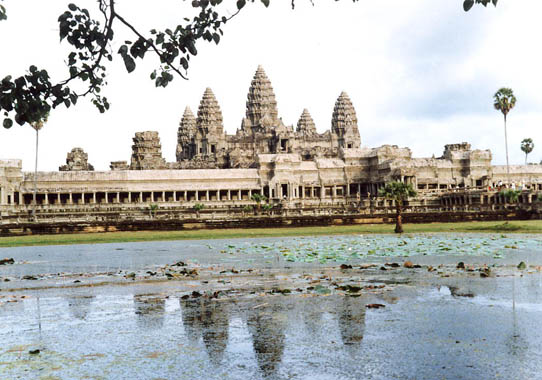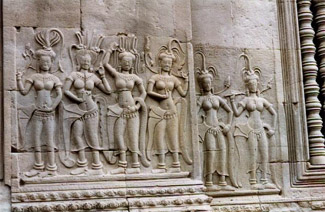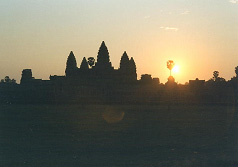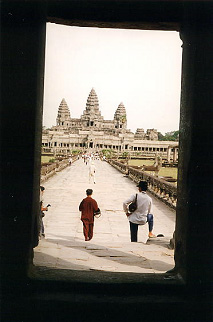
 |
Photo courtesy of www.andybrouwer.co.uk |
Background:
One of the most spectacular structures of astronomical significance that has
ever been built is the temple of Angkor Wat in what is now Cambodia.
Angkor Wat is the most famous temple at Angkor, a former capital of the Khmer empire. It was built by King Suryavarman II in the 12th century, and is as immense as it is beautiful. Surrounded by a rectangular moat 1.5 kilometers (0.9 mile) long and 1.3 kilometers (0.8 mile) wide, the structure itself consists of two rectangular walls enclosing three nested rectangular galleries that culminate in a central spire surrounded by four smaller towers. The straight lines of its moat, walls and galleries are oriented along the north-south, east-west directions, and unlike most temples in the area its entrance faces west, being approached by way of a long bridge that spans the moat.
The origins of the temple lie in what may be the world's oldest religious text, the Rigveda, one of the four Veda Samhitas of Hindu literature. This text describes the gods of heaven and earth, including the earthly god Vishnu, "The Preserver." It is to Vishnu that Angkor Wat is consecrated, and with more than mere symbolic intent. Hindu temples were built to be earthly abodes for the gods. The central sanctuary was the most sacred place, directly inline with the vertical axis of the central spire that provided the connection between the realms of heaven and Earth. The surrounding architecture of the temple would then mirror Hindu cosmology, being essentially a mandala in stone—a diagram of the cosmos itself. Furthermore, the Khmer civilization had by the time of Angkor Wat's construction incorporated the idea that a king would, after his death, be transmuted into one of the gods. Hence, it was at Angkor Wat that Suryavarman II, after his death, was believed to reside as Vishnu.
 |
| Photo courtesy of www.andybrouwer.co.uk |
Astronomical significance:
Astronomy and Hindu cosmology are inseparably entwined at Angkor Wat. Nowhere
is this more evident than in the interior colonnade, which is dedicated to a
vast and glorious carved mural, a bas-relief illustrating the gods as
well as scenes from the Hindu epic the Mahabharata. Along the east
wall is a 45-meter (150-foot) scene illustrating the "churning of the
sea of milk," a creation myth in which the gods attempt to churn the elixir
of immortality out of the milk of time. The north wall depicts the "day
of the gods," along the west wall is a great battle scene from the Mahabharata, and the south wall portrays the kingdom of Yama, the god of death.
It has been suggested that the choice and arrangement of these scenes was intended
to tie in with the seasons—the creation scene of the east wall is symbolic
of the renewal of spring, the "day of the gods" is summer, the great
battle on the west wall may represent the decline of autumn, and the portrayal
of Yama might signify the dormancy, the lifeless time of winter.
 |
| Photo courtesy of www.andybrouwer.co.uk |
The architecture of Angkor Wat also has numerous astronomical aspects beyond the basic mandala plan that is common to other Hindu temples. As many as eighteen astronomical alignments have been identified within its walls. To mention but three of them: when standing just inside the western entrance, the Sun rises over the central tower on the spring (vernal) equinox; it rises over a distant temple at Prasat Kuk Bangro, 5.5 kilometers (3.4 miles) away, on the winter solstice; and on the summer solstice it rises over a prominent hill 17.5 kilometers (10.9 miles) away.
Finally, some researchers have claimed that the very dimensions of many of the structures at Angkor Wat have astronomical associations. These associations emerge from consideration of the unit of length that was in use at that time, a unit known as the hat or "Cambodian cubit." There is some question as to how long a hat was, and indeed its definition may not have been uniformly applied; but a value of 43.45 centimeters (17.1 inches) for the length of a hat is suggested by the structures themselves.
Using this value, archaeologists discovered numerous dimensions of the temple that seem to have astronomical and cosmological significance—for example, the following:
Because of its orbit around the Earth, the Moon's apparent position in the sky relative to the background stars will appear to shift from night to night. Since it takes the Moon just over 27 days to complete one orbit (known as its sidereal period), it will during this time appear to move through 27 successive regions of the sky. In Hindu cosmology, these regions were known as the naksatras, or lunar mansions. In some contexts there were 27 lunar mansions, while in other contexts an additional naksatra containing the star Vega was included, giving 28 lunar mansions.
 |
| Photo courtesy of www.andybrouwer.co.uk |
Hindu cosmology recognizes four time periods, or Yugas, that are represented in the dimensions of the temple:
Rarely in history has any culture given rise to a structure that so elaborately and expansively incorporates its concept of the cosmos. Angkor Wat stands as a striking and majestic monument in honor of the Universe and our place in it.
References:
Kelley, D., and E. Milone, Exploring Ancient Skies: An Encyclopedic Survey
of Archaeoastronomy, Springer, New York, 2005.
Krupp, E.C., Skywatchers, Shamans & Kings: Astronomy and the Archaeology
of Power, John Wiley & Sons, Inc., New York, 1997.
Space
and Cosmology in the Hindu Temple, by Subhash Kak
Other useful links and references:
A photographic tour with maps
Photographs and architectural plans
Photographs of Angkor Wat
More
photographs of Angkor Wat
sacredsites.com
Tourism
of Cambodia (includes a detailed description of the bas-reliefs)